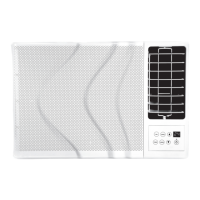PGD4, PGS4, Series G, H WPG4 Series D, H Ultra Low NOx: Installation Instructions
Manufacturer reserves the right to change, at any time, specifications and designs without notice and without obligations.
35
Table 13 – Troubleshooting Chart
SYMPTOM CAUSE REMEDY
Compressor and condenser fan will not start.
Power failure Call power company
Fuse blown or circuit breaker tripped Replace fuse or reset circuit breaker
Defective contactor, transformer, or high-pressure,
loss-of-charge or low-pressure switch
Replace component
Insufficient line voltage Determine cause and correct
Incorrect or faulty wiring Check wiring diagram and rewire correctly
Thermostat setting too high
Lower thermostat temperature setting below
room temperature
Compressor will not start but condenser fan runs
Faulty wiring or loose connections in compressor
circuit
Check wiring and repair or replace
Compressor motor burned out, seized, or
internal overload open
Determine cause
Replace compressor
Defective run/start capacitor, overload, start relay Determine cause and replace
One leg of 3-phase power dead
Replace fuse or reset circuit breaker
Determine cause
Low input voltage Determine cause and correct
Three-phase scroll compressor
makes excessive noise, and there may be a low
pressure differential.
Scroll compressor is rotating in the wrong direction
Correct the direction of rotation by reversing the
3-phase power leads to the unit. Shut down unit
to allow pressures to equalize.
Compressor cycles (other than normally
satisfying thermostat)
Refrigerant overcharge or undercharge
Recover refrigerant, evacuate system, and
recharge to capacities shown on rating plate
Defective compressor Replace and determine cause
Insufficient line voltage Determine cause and correct
Blocked outdoor coil Determine cause and correct
Defective run/start capacitor Determine cause and replace
Faulty outdoor fan motor or capacitor Replace
Restriction in refrigerant system Locate restriction and remove
Compressor operates continuously
Dirty air filter Replace filter
Unit undersized for load Decrease load or increase unit size
Thermostat temperature set too low Reset thermostat
Low refrigerant charge Locate leak, repair, and recharge
Air in system
Recover refrigerant, evacuate system, and
recharge
Outdoor coil dirty or restricted Clean coil or remove restriction
Excessive head pressure
Dirty air filter Replace filter
Dirty condenser coil Clean coil
Refrigerant overcharged Recover excess refrigerant
Air in system
Recover refrigerant, evacuate system, and
recharge
Condenser air restricted or air short-cycling Determine cause and correct
Head pressure too low
Low refrigerant charge Check for leaks, repair, and recharge.
Restriction in liquid tube Remove restriction
Excessive suction pressure Refrigerant overcharged Recover excess refrigerant
Suction pressure too low
Dirty air filter Replace filter
Low refrigerant charge Check for leaks, repair and recharge
Metering device or low side restricted Remove source of restriction
Insufficient evaporator airflow
Increase air quantity
Check filter–replace if necessary
Temperature too low in conditioned area Reset thermostat
Outdoor ambient below 55F (13C) Install low-ambient kit
Filter drier restricted Replace filter

